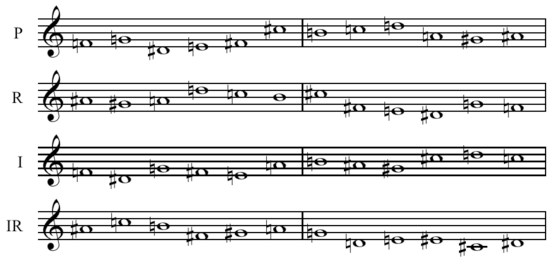Requiem Canticles
Requiem Canticles is a 15-minute composition by Igor Stravinsky, for contralto and bass soli, chorus, and orchestra. Stravinsky completed the work in 1966, and it received its first performance that same year.
The work is a partial setting of the Roman Catholic requiem mass, with the six vocal movements in Latin. It is from Stravinsky's serial period, but it has elements from all his stylistic periods. It was performed at Stravinsky's funeral five years after its initial premiere.
Orchestration
Requiem Canticles is scored for contralto and bass soloists, mixed chorus, and an orchestra consisting of 3 flutes (3rd doubles on piccolo), alto flute, 2 bassoons, 4 horns, 2 trumpets, 3 trombones, timpani (2 performers), 2 percussionists (xylophone, vibraphone, and tubular bells), harp, piano, celesta, and strings.
Structure
The piece consists of 9 short movements:
- 1. Prelude
- 2. Exaudi
- 3. Dies Irae
- 4. Tuba mirum
- 5. Interlude
- 6. Rex tremendae
- 7. Lacrimosa
- 8. Libera me
- 9. Postlude
Joseph N. Straus has discussed in detail Stravinsky's particular application of serial technique in the work, and his devising and use of a system of "rotational arrays" and "four-part arrays" in composing the work.[1][2] David Smyth has noted Stravinsky's incorporation of the "B-A-C-H" (B flat-A-C-B natural) motif in the work.[3]
Requiem Canticles is characteristic of Stravinsky's twelve-tone practice in that he preferred the inverse-retrograde (IR) to the typical retrograde-inverse (RI):

References
- ↑ Straus, Joseph N. (Summer 1997). "Babbitt and Stravinsky under the Serial "Regime"". Perspectives of New Music. 35 (2): 17–32. doi:10.2307/833640. JSTOR 745920.
- ↑ Straus, Joseph N. (Spring 1999). "Stravinsky's "Construction of Twelve Verticals": An Aspect of Harmony in the Serial Music". Music Theory Spectrum. 21 (1): 43–73. doi:10.1525/mts.1999.21.1.02a00030. JSTOR 745920.
- ↑ Smyth, David (Summer 1999). "Stravinsky's Second Crisis: Reading the Early Serial Sketches". Perspectives of New Music. 37 (2): 117–146. doi:10.2307/833512. JSTOR 833512.
- ↑ Whittall, Arnold. 2008. The Cambridge Introduction to Serialism. Cambridge Introductions to Music, p.139. New York: Cambridge University Press. ISBN 978-0-521-68200-8 (pbk).
Sources
- Samson, Jim (1995). "Igor Stravinsky: The Rite of Spring, etc". In Stravinsky: The Rite of Spring, Requiem Canticles, Canticum Sacrum (pp. 6–9) [CD booklet]. Colchester, Essex, England: Chandos Records.
External links
- Boosey & Hawkes page on Requiem Canticles
- California Institute of Technology page on Requiem Canticles
- Payne, Anthony. "Requiem Canticles". Tempo. 81 (Summer (1967)): 10–19.
- Perry, Jeffrey. "A "Requiem for the Requiem": On Stravinsky's Requiem Canticles". College Music Symposium. 33/34 (1993/1994): 237–56. Retrieved July 2013. Check date values in:
|access-date=(help)